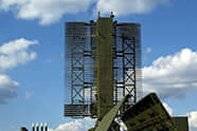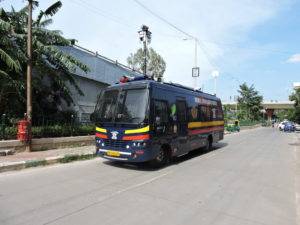Introduction
With the growing interest in Wireless IP Video Surveillance solutions, thanks to the increasing demand for IP-based video surveillance, it is necessary to point out certain features of these solutions that differentiate them from their wired counterparts; so that users can design their surveillance infrastructure to factor in these characteristics, for critical installations.
There are three areas of concern when using Wi-fi for critical video surveillance requirements:
- The susceptibility of the medium to jamming and snooping
- The base station-centric topology implemented in most Wi-fi networks
- The importance of the Network Video Recorder (NVR), both as a communications hub and as a repository of data, in a Wi-fi network
Wi-fi Jamming and Snooping
All RF (Radio Frequency) signals are prone to jamming and snooping, and Wi-fi is no different. Wi-fi jamming can happen at the physical layer, typically when the attacker does not have access to the Wi-fi network; and at the MAC layer, when the attacker has access to the Wi-fi network. Wi-fi jamming, at both the physical layer and the MAC layer, is easy to perpetrate and does not require highly sophisticated or expensive equipment. Similarly, with off-the-shelf equipment available these days, tapping RF signals does not require a high level of expertise or skill.
The IEEE 802.11n standard supports features that make it less susceptible to jamming than the other Wi-fi standards (802.11b and 802.11g).
MIMO
Multiple-Input/Multiple-Output (MIMO) technology makes 802.11n more resilient to jamming. The presence of two or more antennae on each Wi-fi device makes the job of jamming signals at the device harder. Obviously, 3×3 and 4×4 MIMO devices offer even greater protection.
Dual Frequency Support
IEEE 802.11n supports transmission in the 2.4 GHz and 5 GHz bands (using a 20 MHz or 40 MHz pipe). This allows an 802.11n device to switch transmission to the alternative frequency, if the frequency it is using is being jammed.
Antenna
The use of directional antennae and high-gain antennae makes the jamming task more difficult. This is a feature available to all RF devices, and is not specific to IEEE 802.11n devices.
As far as snooping is concerned, the support for the IEEE 802.11i security standard ensures that the intercepted signal will be difficult to decrypt. Details on the IEEE 802.11i standard were provided in an earlier Tech. Brief (Wireless LAN IP Surveillance – Security of Content).
Wi-fi Topology
Wi-fi networks typically use a point-to-multipoint topology, in that the base station (say, an NVR) serves as the hub for a cluster of clients (say, surveillance cameras); and base stations set up links with each other. Such a topology renders clients vulnerable to being unable to communicate, if the base station goes down or, if for some reason, the link between a client and the base station cannot be established.
The IEEE 802.11 standards specify an ad-hoc mode (Independent Basic Service Set – IBSS), which allows a client to establish a link with another client, for transfer of data. On paper, the ad-hoc mode allows peer-to-peer networking, thereby allowing clients to communicate even in the absence of a base station. However, in its practical implementation there is no guarantee on the quality of service for communications that take place in the ad-hoc mode; especially with respect to video transmission.
There are proprietary implementations of the IEEE 802.11n standard that support a mesh network topology among wireless devices (vendors such as Firetide, Fluidmesh, Meraki, Motorola, etc.), but such implementations are expensive since they require specialized devices to be attached to each device in the mesh. Specialised Wi-fi chipsets have started appearing in the market, seeking to deliver mesh networking capability to Wi-fi devices; but, again, these tend to be expensive and typically do not work with chipsets supporting just the IEEE 802.11n standard. In order to address the lack of standards in this space as well as the lack of backward compatibility, the Wi-Fi Alliance has announced the Wi-Fi Direct standard. This year should see the release of devices supporting Wi-Fi Direct.
NVR Redundancy
The NVR is the communications hub and storage repository in a wireless IP video surveillance set-up. The wireless cameras associate with an NVR, during installation, and will be unable to transmit the captured content unless the NVR is in a position to receive the feed. The NVR is a compact computer in its own right, with sufficient computing power to encode/decode multiple compressed video streams; with on-board storage to record the captured content; and with the wherewithal to connect to an IP backbone and make available the recorded content anywhere on the Internet.
Given its importance in the surveillance set-up, it is critical that a user plans some level of redundancy with respect to the NVR. There are two connection options available to a user, for NVR redundancy:
Cold Stand-by
In this arrangement, an additional NVR (secondary NVR) is powered on and running, but not associated with any of the wireless cameras in the Wi-fi network. The secondary NVR is configured exactly like the primary NVR. Should the primary NVR fail, the administrator/user manually reassigns the wireless cameras to the secondary NVR, and restarts recording. The entire process takes less than five minutes.
Hot Stand-by
In this arrangement, an additional NVR (secondary NVR) is powered on and connected over a dedicated Ethernet link to the primary NVR. Whatever is received and recorded on the primary NVR is transmitted to the secondary NVR, in real-time, and recorded. If the primary NVR fails (as sensed by the OS on the secondary server), the secondary NVR takes over and automatically routes the content to its on-board storage. The changeover takes less than a minute, following which the secondary NVR is re-designated the primary NVR, until such time the non-functional NVR is brought up and synchronized with the active NVR
Conclusion
Users implementing video surveillance systems built around the IEEE 802.11 communications standards will need to ensure that their installations take care of the above Wi-fi-related characteristics, in order to deliver robust performance.
The Mistral Smartvue Wireless IP Video Surveillance solution supports the IEEE 802.11n and IEEE 802.11i standards, making it less susceptible to jamming and snooping; and supports cold stand-by NVR redundancy, thus allowing the network to function even in the event of a base-station failure.



